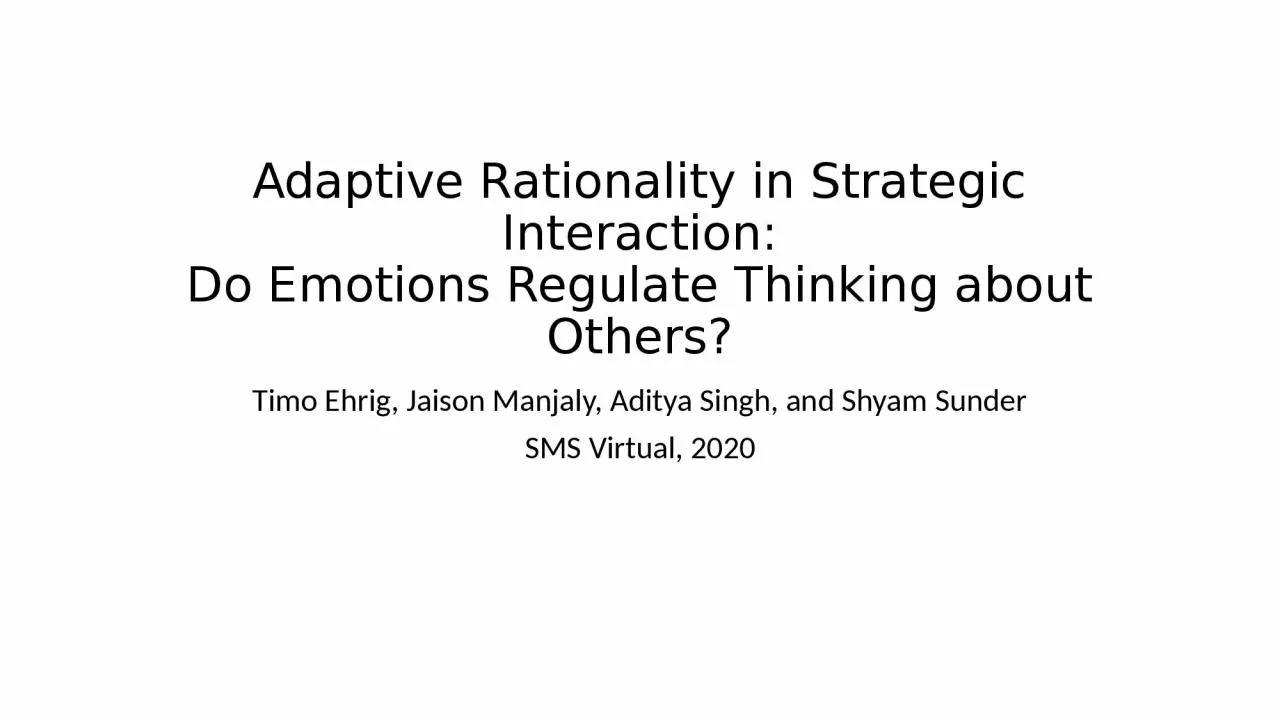

Do Emotions Regulate Thinking about Others Timo Ehrig Jaison Manjaly Aditya Singh and Shyam Sunder SMS Virtual 2020 An Overview Role of expectations about others behavior in strategy Standard assumption in economics game theory perhaps also management expectations are formed by reas ID: 1028271
Download Presentation The PPT/PDF document "Adaptive Rationality in Strategic Intera..." is the property of its rightful owner. Permission is granted to download and print the materials on this web site for personal, non-commercial use only, and to display it on your personal computer provided you do not modify the materials and that you retain all copyright notices contained in the materials. By downloading content from our website, you accept the terms of this agreement.
1. Adaptive Rationality in Strategic Interaction:Do Emotions Regulate Thinking about Others?Timo Ehrig, Jaison Manjaly, Aditya Singh, and Shyam SunderSMS Virtual, 2020
2. An OverviewRole of expectations about others’ behavior in strategyStandard assumption in economics/ game theory (perhaps also management): expectations are formed by reasoning iteratively about each other.Attempts to understand cognitive short cuts in iterative reasoningExplore potential role of emotions in regulating the depth of iterative reasoningPreliminary evidence from a beauty contest guessing game lab experimentNegative emotion (fear) greater depth of reasoning than under positive emotion (amusement)But neutral emotion exhibit the greatest depth of reasoningPossible implications: Could emotions be a component of rational heuristics in novel environments?Emotions as enabler of rational behavior?Many open questions
3. Levels of ReasoningThe “common belief in rationality” GT solution to form expectations about others is neither realistic (Bettis, 2017), nor functional.Team coordination example: How many confirmations are necessary to know that something is commonly agreed upon?Once environments change, standards of coordination may change (does our team coordinate on the same level of reasoning when everyone is in home office)?Competitor interaction: Reasoning deeper than others can bring advantages. But GT solution may not be the best here, too!Explicitly or implicitly, we need to choose levels of reasoning.Different situations may require different levels of reasoning.
4. Our Tentative ProposalFocus on functionality of human emotional endowment as an enabler, not a disrupter, of rationality (Argyris, Simon).Key idea: some emotions increase, some decrease the levels of reasoning.Conjecture: Negative emotions (eg fear) increase levels of reasoning, positive emotions (eg amusement) decrease levels of reasoning.
5. ExperimentPrime subjects on the emotions using short video clips (with manipulation checks)1. Positive (amusement) and 2. Negative (fear)Let primed subjects play Nagel’s guessing game (to estimate their levels of reasoning)In each round, the subjects are asked to choose a number between 0 and 1000 (inclusive) with the understanding that the average of the ten (simultaneously entered) numbers will be multiplied by 2/3 to calculate the target number for that round. The subject whose chosen number is closest to the target number wins a fixed reward.Conjecture: Fear drives levels of reasoning up; amusement will keeps levels of reasoning lowUse a third treatment for control: Neutral (nature); we had conjectured that it will have no effect on levels of reasoning
6. Figure 1: Means of numbers chosen in feedback rounds (Panel B) across positive, neutral, and negative emotion groups
7. Feedback RoundsPositive: 233.8 (258)Neutral: 74.1 (98)Negative: 152.6 (196)All group difference significant at p < 0.01No significant decrease over 7 rounds under positive emotion, but significant decrease under negative and neutral emotions
8. Open QuestionsNeed future validation to rule out other effects of emotionSimon (1967): emotions may help regulate thinkingAre emotions a key part of rational heuristics, that is, decision rules that economize on time, cost, computational effort and that may lead to better outcomes than attempts to reasons without bounds?As forming expectations about others is key to most strategic decisions (and indeed, theories of competitive advantage!) we need further work to understand the link of emotions of levels of reasoning.
9. Thank You